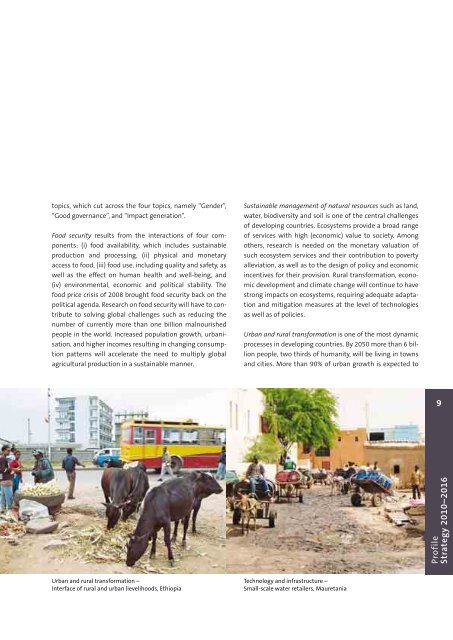NORTH-SOUTH CENTRE - ETH - North-South Centre North-South ...
NORTH-SOUTH CENTRE - ETH - North-South Centre North-South ...
NORTH-SOUTH CENTRE - ETH - North-South Centre North-South ...
You also want an ePaper? Increase the reach of your titles
YUMPU automatically turns print PDFs into web optimized ePapers that Google loves.
topics, which cut across the four topics, namely “Gender”,<br />
“Good governance”, and “Impact generation”.<br />
Food security results from the interactions of four components:<br />
(i) food availability, which includes sustainable<br />
production and processing, (ii) physical and monetary<br />
access to food, (iii) food use, including quality and safety, as<br />
well as the effect on human health and well-being, and<br />
(iv) environmental, economic and political stability. The<br />
food price crisis of 2008 brought food security back on the<br />
political agenda. Research on food security will have to contribute<br />
to solving global challenges such as reducing the<br />
number of currently more than one billion malnourished<br />
people in the world. Increased population growth, urbanisation,<br />
and higher incomes resulting in changing consumption<br />
patterns will accelerate the need to multiply global<br />
agricultural production in a sustainable manner.<br />
Sustainable management of natural resources such as land,<br />
water, biodiversity and soil is one of the central challenges<br />
of developing countries. Ecosystems provide a broad range<br />
of services with high (economic) value to society. Among<br />
others, research is needed on the monetary valuation of<br />
such ecosystem services and their contribution to poverty<br />
alleviation, as well as to the design of policy and economic<br />
incentives for their provision. Rural transformation, economic<br />
development and climate change will continue to have<br />
strong impacts on ecosystems, requiring adequate adaptation<br />
and mitigation measures at the level of technologies<br />
as well as of policies.<br />
Urban and rural transformation is one of the most dynamic<br />
processes in developing countries. By 2050 more than 6 billion<br />
people, two thirds of humanity, will be living in towns<br />
and cities. More than 90% of urban growth is expected to<br />
9<br />
Profile<br />
Strategy 2010–2016<br />
Urban and rural transformation –<br />
Interface of rural and urban lievelihoods, Ethiopia<br />
Technology and infrastructure –<br />
Small-scale water retailers, Mauretania
















